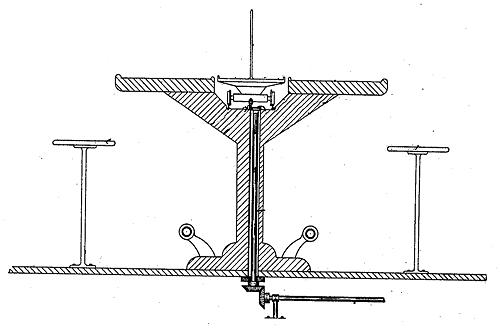Baitinger’s Automatic Eater
I posted last week about a 1940's invention which envisioned putting restaurant diners on a conveyor belt so that they could be carried past food stations. Several readers commented that the Japanese have embraced the opposite concept, of putting the food on a conveyor belt so that it travels past the diners.
I did some research and discovered that the origin of the idea of having food on a conveyor belt traces all the way back to 1919 when John Moses Baitinger of Minnesota applied for a patent on this concept, which he called his "Automatic Eater". His patent was granted in 1923. He had small wooden cars, laden with food and drinks, moving along tracks, pulled by a system of cables.


Karal Ann Marling discusses some of the history of Baitinger's invention in her book Blue Ribbon: A Social and Pictorial History of the Minnesota State Fair:

I did some research and discovered that the origin of the idea of having food on a conveyor belt traces all the way back to 1919 when John Moses Baitinger of Minnesota applied for a patent on this concept, which he called his "Automatic Eater". His patent was granted in 1923. He had small wooden cars, laden with food and drinks, moving along tracks, pulled by a system of cables.


Karal Ann Marling discusses some of the history of Baitinger's invention in her book Blue Ribbon: A Social and Pictorial History of the Minnesota State Fair:
One of the strangest devices ever seen at the Minnesota State Fair was Baitinger's Automatic Eater. A kind of mechanized restaurant, the Eater consisted of a 150-foot-long counter along which moved a procession of eighty-five wooden cars propelled by a system of cables embedded in a groove in the surface. The cars held food, and diners snatched for their favorite dishes as the train coursed past. Some cars had drawers filled with ice, to keep fruit or celery fresh; some were warmed with heated soapstones.
The ensemble was the invention of the Reverend J.M. Baitinger, an Evangelic churchman, who stationed himself out in front with a megaphone to ballyhoo a new era in state fair dining: "Haba! Haba! Haba! This is the place to be merry. Eat! Eat! Eat! All you want for 50 cents; for without a full stomach you cannot enjoy the fair. Haba! Haba! Haba!"
The Automatic Eater cost Baitinger more than one thousand dollars to build but, because of its novelty and the economies it permitted, the cafe more than paid for itself during a trial run conducted on the last few days of the 1920 fair. "Through the medium of the Automatic Eater," he stated the following summer, "I do away with all excess help and employ only one cook, a dish washer, and a woman to keep the train well stocked with food. I pay no attention to what my customers eat, how long they stay or how much food they consume." But there were healthy profits, which Baitinger turned over to a St. Paul hospital.
Baitinger's Eater was, in many ways, a perfect expression of the mentality of the automation-mad 1920s, obsessed with speed, technology, and efficiency. There were minor drawbacks to the system, however. Diners seated near the end of the line sometimes found that the only cargo left for the eating was boiled cabbage.
The ensemble was the invention of the Reverend J.M. Baitinger, an Evangelic churchman, who stationed himself out in front with a megaphone to ballyhoo a new era in state fair dining: "Haba! Haba! Haba! This is the place to be merry. Eat! Eat! Eat! All you want for 50 cents; for without a full stomach you cannot enjoy the fair. Haba! Haba! Haba!"
The Automatic Eater cost Baitinger more than one thousand dollars to build but, because of its novelty and the economies it permitted, the cafe more than paid for itself during a trial run conducted on the last few days of the 1920 fair. "Through the medium of the Automatic Eater," he stated the following summer, "I do away with all excess help and employ only one cook, a dish washer, and a woman to keep the train well stocked with food. I pay no attention to what my customers eat, how long they stay or how much food they consume." But there were healthy profits, which Baitinger turned over to a St. Paul hospital.
Baitinger's Eater was, in many ways, a perfect expression of the mentality of the automation-mad 1920s, obsessed with speed, technology, and efficiency. There were minor drawbacks to the system, however. Diners seated near the end of the line sometimes found that the only cargo left for the eating was boiled cabbage.

Comments
You really, really, really want to sit near the kitchen, especially during cold and flu season.
It's basically a buffet, which is the horror of the food industry. You think quantum mechanics is tough, try figuring out how to make a profit when preparing small batches with limited serving life and having no portion control. Anyone who says they make a profit on a buffet is either a liar or made a deal with the devil.
It's basically a buffet, which is the horror of the food industry. You think quantum mechanics is tough, try figuring out how to make a profit when preparing small batches with limited serving life and having no portion control. Anyone who says they make a profit on a buffet is either a liar or made a deal with the devil.
Posted by Phideaux on 02/28/21 at 01:59 PM
I could see where something like this could be useful in an institutional setting where you need to feed a lot of people quickly, such as a prison...
Posted by Brian on 03/04/21 at 09:36 PM
Commenting is not available in this channel entry.

Category: Food | Inventions | Patents | Restaurants | 1910s